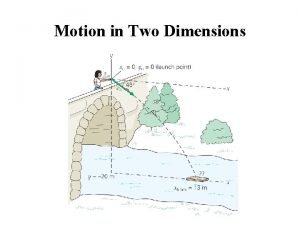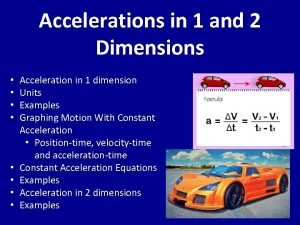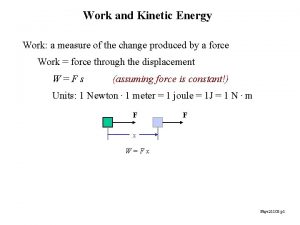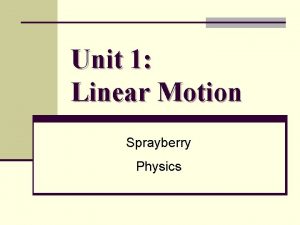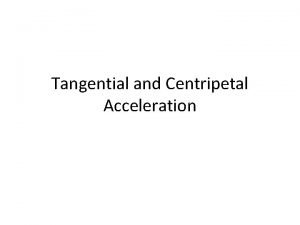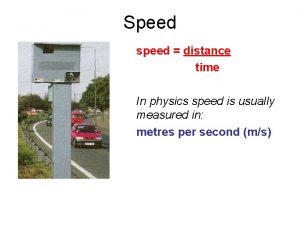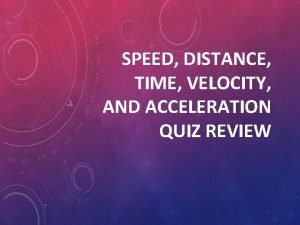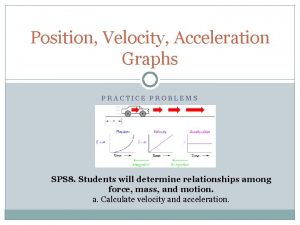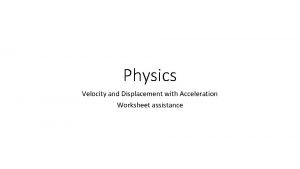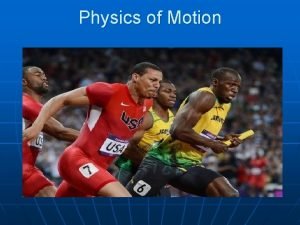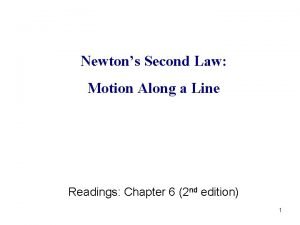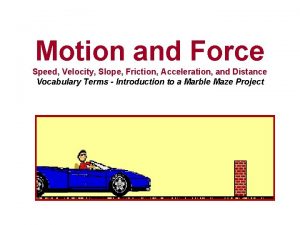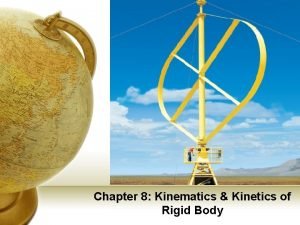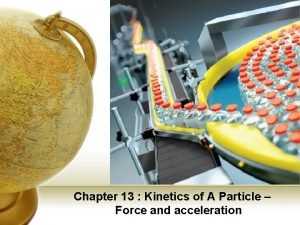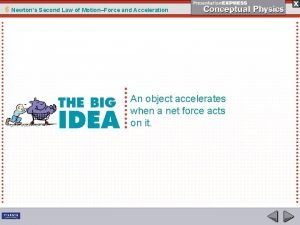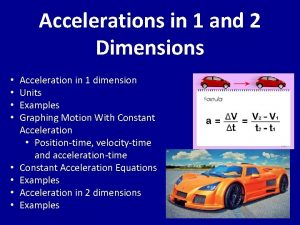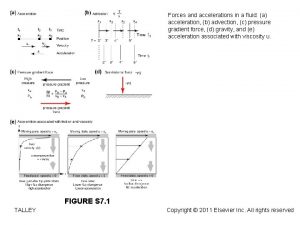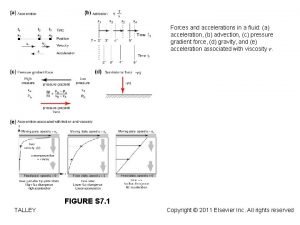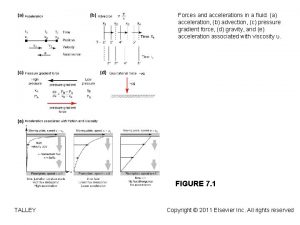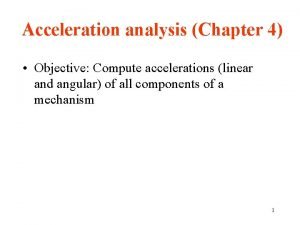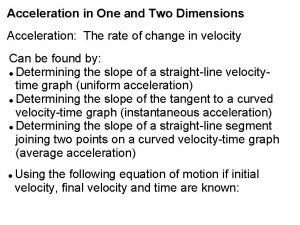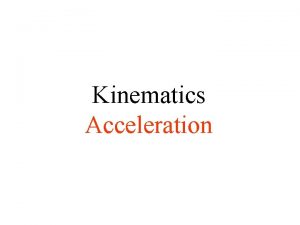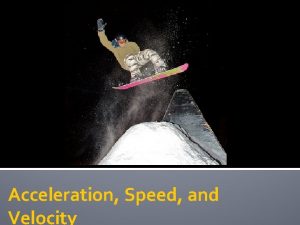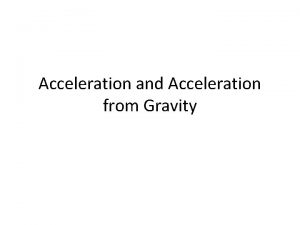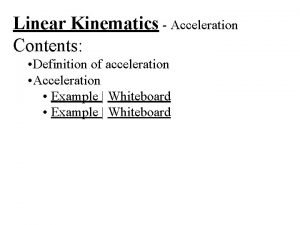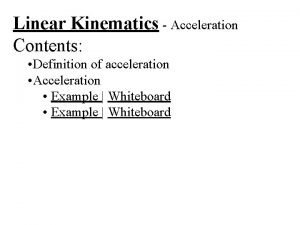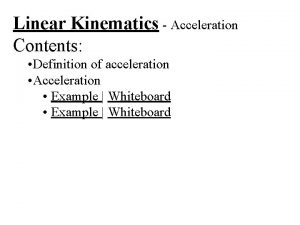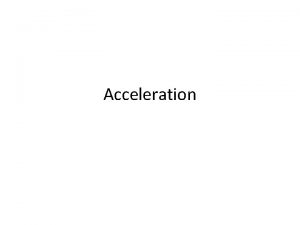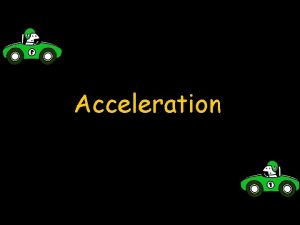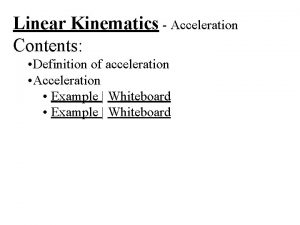Accelerations in 1 and 2 Dimensions Acceleration in



![Example 1 • A racing car accelerates from rest to 96 km/h [W] in Example 1 • A racing car accelerates from rest to 96 km/h [W] in](https://slidetodoc.com/presentation_image_h/11ae0c7dc24be88db2d2b66df9b34fee/image-4.jpg)
![Example 2 • A motorcyclist travelling at 23 m/s [N] applies the brakes, producing Example 2 • A motorcyclist travelling at 23 m/s [N] applies the brakes, producing](https://slidetodoc.com/presentation_image_h/11ae0c7dc24be88db2d2b66df9b34fee/image-5.jpg)

![Check Your Understanding Solutions 4. 2. 4 m/s 2 [fwd] 5. (a) 2. 80 Check Your Understanding Solutions 4. 2. 4 m/s 2 [fwd] 5. (a) 2. 80](https://slidetodoc.com/presentation_image_h/11ae0c7dc24be88db2d2b66df9b34fee/image-7.jpg)












![Check Your Understanding • A motorcyclist, travelling initially at 12 m/s [W], changes gears Check Your Understanding • A motorcyclist, travelling initially at 12 m/s [W], changes gears](https://slidetodoc.com/presentation_image_h/11ae0c7dc24be88db2d2b66df9b34fee/image-20.jpg)
![Check Your Understanding • A motorcyclist, travelling initially at 12 m/s [W], changes gears Check Your Understanding • A motorcyclist, travelling initially at 12 m/s [W], changes gears](https://slidetodoc.com/presentation_image_h/11ae0c7dc24be88db2d2b66df9b34fee/image-21.jpg)

![Practice - Answers 1. 2. 3. 4. 44 m/s [W] 4. 6 x 104 Practice - Answers 1. 2. 3. 4. 44 m/s [W] 4. 6 x 104](https://slidetodoc.com/presentation_image_h/11ae0c7dc24be88db2d2b66df9b34fee/image-23.jpg)

![Check Your Understanding 1. A car with a velocity of 25 m/s [E] changes Check Your Understanding 1. A car with a velocity of 25 m/s [E] changes](https://slidetodoc.com/presentation_image_h/11ae0c7dc24be88db2d2b66df9b34fee/image-25.jpg)


- Slides: 27

Accelerations in 1 and 2 Dimensions • • Acceleration in 1 dimension Units Examples Graphing Motion With Constant Acceleration • Position-time, velocity-time and acceleration-time Constant Acceleration Equations Examples Acceleration in 2 dimensions Examples

Acceleration • Acceleration is the rate of change of velocity • Velocity is a vector quantity therefore, acceleration is also a vector quantity • Average acceleration, aav, is the change in velocity divided by the time interval for that change: • where vf is the final velocity, vi is the initial velocity, and Δt is the time interval. • Instantaneous acceleration is the acceleration any particular instant —but often just referred to as acceleration

Acceleration Units • What units do you end up with for acceleration? = m/s 2 s • Acceleration is the change in velocity (m/s) over time (s) m/s 2
![Example 1 A racing car accelerates from rest to 96 kmh W in Example 1 • A racing car accelerates from rest to 96 km/h [W] in](https://slidetodoc.com/presentation_image_h/11ae0c7dc24be88db2d2b66df9b34fee/image-4.jpg)
Example 1 • A racing car accelerates from rest to 96 km/h [W] in 4. 1 s. Determine the average acceleration of the car.
![Example 2 A motorcyclist travelling at 23 ms N applies the brakes producing Example 2 • A motorcyclist travelling at 23 m/s [N] applies the brakes, producing](https://slidetodoc.com/presentation_image_h/11ae0c7dc24be88db2d2b66df9b34fee/image-5.jpg)
Example 2 • A motorcyclist travelling at 23 m/s [N] applies the brakes, producing an average acceleration of 7. 2 m/s 2 [S]. What is the motorcyclist’s velocity after 2. 5 s?

Check Your Understanding 1. 2. 3. 4. 5. 6. 7. Is it possible to have acceleration when the velocity is zero? If “no, ” explain. Is it possible to have an eastward velocity with a westward acceleration? If “no, ” explain why not. If “yes, ” give an example. A flock of robins is migrating southward. Describe the flock’s motion at instants when its acceleration is (a) positive, (b) negative, and (c) zero. Take the south- ward direction as positive. A track runner, starting from rest, reaches a velocity of 9. 3 m/s [fwd] in 3. 9 s. Determine the runner’s average acceleration. The Renault Espace is a production car that can go from rest to 26. 7 m/s with an incredibly large average acceleration of magnitude 9. 52 m/s 2. (a) How long does the Espace take to achieve its speed of 26. 7 m/s? (b) What is this speed in kilometres per hour? The fastest of all fishes is the sailfish. If a sailfish accelerates at a rate of 14 (km/h)/s [fwd] for 4. 7 s from its initial velocity of 42 km/h [fwd], what is its final velocity? An arrow strikes a target in an archery tournament. The arrow undergoes an average acceleration of 1. 37 x 103 m/s 2 [W] in 3. 12 x 10 -2 s then stops. Determine the velocity of the arrow when it hits the target.
![Check Your Understanding Solutions 4 2 4 ms 2 fwd 5 a 2 80 Check Your Understanding Solutions 4. 2. 4 m/s 2 [fwd] 5. (a) 2. 80](https://slidetodoc.com/presentation_image_h/11ae0c7dc24be88db2d2b66df9b34fee/image-7.jpg)
Check Your Understanding Solutions 4. 2. 4 m/s 2 [fwd] 5. (a) 2. 80 s (b) 96. 1 km/h 6. 108 km/h [fwd] 7. 42. 8 m/s [E]

What’s the cars average acceleration? Lamborghini LP 700 -4 Aventador – Click Image

Graphing Motion with Constant Acceleration • A speedboat accelerates uniformly from rest for 8. 0 s, with a displacement of 128 m [E] over that time interval. See the position-time graph below • The tangents represent the instantaneous velocities

• The velocity–time graph is on the right. It shows the instantaneous velocities as determined by the slopes of the tangents from the position-time graph (left)

• The acceleration can be determined from the slope of the line on the velocity-time which is • In this example, the slope, and thus the acceleration, is 8. 0 m/s 2 [E].

P-T, V-T and A-T Graphs

What the graphs tell us • The area under the line on a velocity-time graph indicates the change in position over the time interval • The area under the line on an accelerationtime graph indicates the change in velocity over the time interval

Check Your Understanding • This is the acceleration-time graph of a car accelerating through its first three gears. Assume that the initial velocity is zero. (a) Use the information in the graph to determine the final velocity in each gear. Draw the corresponding velocity-time graph. (b) From the velocity time graph, determine the car’s displacement from its initial position after 5. 0 s.

Check Your Understanding - Solutions

Check Your Understanding Solutions

Check Your Understanding 1. This chart summarizes observations of a crawling baby experiencing constant acceleration over several successive 2. 0 -s intervals. (a) Draw a velocity-time graph for this motion. (b) Use the information on your velocity-time graph to draw the corresponding acceleration-time graph. Time (s) 0 2 4 6 8 10 Velocity 10 15 20 15 10 5

Constant Acceleration Equations • Use these equations to solve motion problems involving acceleration, displacement, time and velocity.

Solving Equations • Whenever you are faced with a word problem the first thing you need to do is determine what is given and what unknown including all units. By doing this you will prevent a lot of mistakes.
![Check Your Understanding A motorcyclist travelling initially at 12 ms W changes gears Check Your Understanding • A motorcyclist, travelling initially at 12 m/s [W], changes gears](https://slidetodoc.com/presentation_image_h/11ae0c7dc24be88db2d2b66df9b34fee/image-20.jpg)
Check Your Understanding • A motorcyclist, travelling initially at 12 m/s [W], changes gears and speeds up for 3. 5 s with a constant acceleration of 5. 1 m/s 2 [W]. What is the motorcyclist’s displacement over this time interval? 1) Determine your Given(s) and Unknown(s)
![Check Your Understanding A motorcyclist travelling initially at 12 ms W changes gears Check Your Understanding • A motorcyclist, travelling initially at 12 m/s [W], changes gears](https://slidetodoc.com/presentation_image_h/11ae0c7dc24be88db2d2b66df9b34fee/image-21.jpg)
Check Your Understanding • A motorcyclist, travelling initially at 12 m/s [W], changes gears and speeds up for 3. 5 s with a constant acceleration of 5. 1 m/s 2 [W]. What is the motorcyclist’s displacement over this time interval? 2) Solve and write your concluding statement

Practice 1. 2. 3. 4.
![Practice Answers 1 2 3 4 44 ms W 4 6 x 104 Practice - Answers 1. 2. 3. 4. 44 m/s [W] 4. 6 x 104](https://slidetodoc.com/presentation_image_h/11ae0c7dc24be88db2d2b66df9b34fee/image-23.jpg)
Practice - Answers 1. 2. 3. 4. 44 m/s [W] 4. 6 x 104 m/s 2 [N] a) 15 m [fwd] b) 8. 3 m/s[fwd] 5. 60 x 1015 m/s 2 [W] b) 9. 39 x 10 -9 s

Acceleration in 2 dimensions • Acceleration in two dimensions occurs when the velocity of an object moving in a plane undergoes a change in magnitude, or a change in direction, or a simultaneous change in both magnitude and direction. • The same equations apply and since it involves vector subtraction, the equations can also be applied to the components of vectors.
![Check Your Understanding 1 A car with a velocity of 25 ms E changes Check Your Understanding 1. A car with a velocity of 25 m/s [E] changes](https://slidetodoc.com/presentation_image_h/11ae0c7dc24be88db2d2b66df9b34fee/image-25.jpg)
Check Your Understanding 1. A car with a velocity of 25 m/s [E] changes its velocity to 25 m/s [S] in 15 s. Calculate the car’s average acceleration. 2. A watercraft with an initial velocity of 6. 4 m/s [E] undergoes an average acceleration of 2. 0 m/s 2 [S] for 2. 5 s. What is the final velocity of the watercraft?

1. Check Your Understanding Answers

Check Your Understanding Answers 2.
 How are linear quantities related to angular quantities
How are linear quantities related to angular quantities Kinetic angular energy
Kinetic angular energy Tangential acceleration and centripetal acceleration
Tangential acceleration and centripetal acceleration Centripital acceleration
Centripital acceleration Is radial acceleration the same as centripetal acceleration
Is radial acceleration the same as centripetal acceleration Vy=gt
Vy=gt How to calculate horizontal displacement
How to calculate horizontal displacement Dimension of acceleration
Dimension of acceleration Acceleration and kinetic energy
Acceleration and kinetic energy What is the difference between velocity and acceleration
What is the difference between velocity and acceleration Tangential speed
Tangential speed Velocity
Velocity Speed equals distance divided by time
Speed equals distance divided by time Acceleration quiz
Acceleration quiz Speed, velocity and acceleration problems
Speed, velocity and acceleration problems What is the relative velocity
What is the relative velocity Positive velocity and negative acceleration graph
Positive velocity and negative acceleration graph Displacement and velocity worksheet
Displacement and velocity worksheet Difference between velocity and acceleration
Difference between velocity and acceleration Find acceleration
Find acceleration Friction force
Friction force Microsoft internet security and acceleration
Microsoft internet security and acceleration Newton's law
Newton's law Kinetics of rigid bodies
Kinetics of rigid bodies Kinetics of a particle force and acceleration
Kinetics of a particle force and acceleration Laws of acceleration
Laws of acceleration Speed, velocity, and acceleration
Speed, velocity, and acceleration Speed & distance formula
Speed & distance formula






